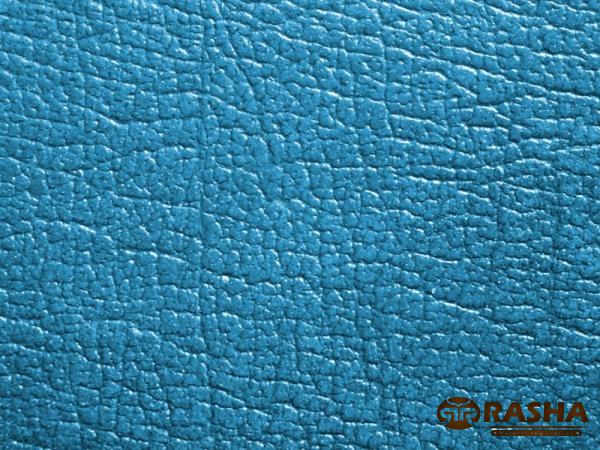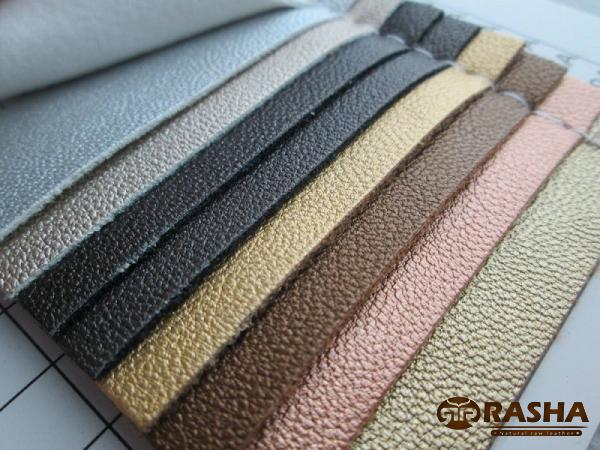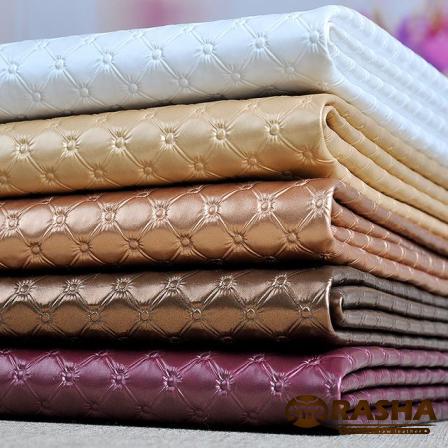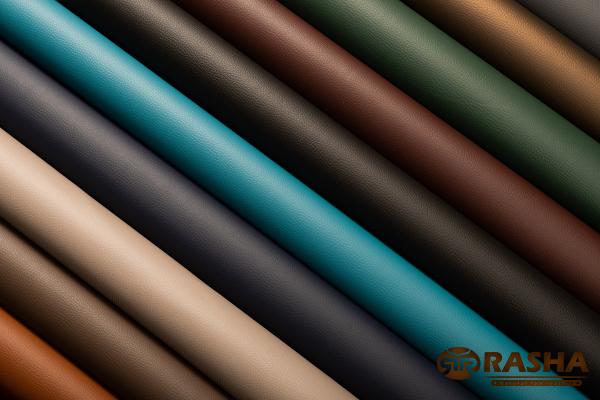PVC leather, also known as faux leather or vinyl leather, is a synthetic material that has gained popularity in various industries due to its versatility, durability, and cost-effectiveness. PVC (polyvinyl chloride) is a type of plastic that is mixed with additives to give the material a leather-like appearance and texture. One of the key advantages of PVC leather is its versatility in terms of applications. It can be used in the manufacturing of a wide range of products, including furniture upholstery, automotive interiors, footwear, clothing, handbags, and accessories. PVC leather offers a cost-effective alternative to genuine leather, allowing manufacturers to produce products at a lower price point without compromising on quality. The durability of PVC leather is another noteworthy feature. It is resistant to wear and tear, making it ideal for products that are subjected to frequent use or exposure to harsh conditions. PVC leather does not crack or fade easily, and it is also water-resistant, which adds to its longevity. These properties make PVC leather a popular choice for furniture upholstery, where it needs to withstand daily wear and spills. In addition to its durability, PVC leather is known for its low maintenance requirements. It can be easily cleaned with a damp cloth or mild soap, making it a practical choice for products that are prone to dirt or spills. Unlike genuine leather, PVC leather does not require regular conditioning or special treatments to maintain its appearance and texture. PVC leather’s versatility is also evident in its wide range of available colors, patterns, and finishes. Manufacturers can create products with a variety of textures, including smooth, grain, or embossed patterns to mimic the look of genuine leather. This allows designers to incorporate PVC leather into their products while achieving the desired aesthetic appeal. From an environmental perspective, PVC leather has drawn some criticism due to its use of chemicals and potential for environmental pollution.

leather
 PVC itself is not a naturally occurring material and requires the use of additives during its production process. Some of these additives, such as plasticizers and stabilizers, have raised concerns about their potential impact on human health and the environment. However, advancements in technology and regulations have led to the development of more environmentally friendly alternatives with reduced health risks. The automotive industry has been one of the significant adopters of PVC leather. It is commonly used in the manufacturing of car seats, dashboards, door panels, and other interior components. PVC leather offers several benefits for automotive applications, including its ability to withstand high temperatures, resistance to UV rays, ease of cleaning, and durability against wear and tear from continuous use. PVC leather has also found extensive use in the furniture industry. Sofas, chairs, and other upholstery products made with PVC leather are popular due to their affordability and wide range of designs. PVC leather can closely resemble genuine leather, providing a sophisticated and luxurious appearance to furniture pieces. Its durability and resistance to stains make it an ideal choice for households with children or pets. In the fashion industry, PVC leather has become a trendy and sought-after material. It is commonly used in the production of jackets, pants, skirts, handbags, and shoes. PVC leather offers designers the ability to create unique and fashionable pieces while maintaining affordability for consumers. The material’s versatile texture options, including glossy, matte, or metallic finishes, allow designers to experiment and create visually appealing products. Despite its popularity and advantages, PVC leather has faced criticism for its potential environmental impact. The manufacturing process of PVC leather involves the use of chemicals, some of which can be harmful if not managed properly. However, through improved production techniques and increased awareness of environmental concerns, efforts are being made to develop more sustainable and eco-friendly alternatives. In conclusion, PVC leather is a versatile and durable material that has found wide-ranging applications in various industries. Its affordability, low maintenance requirements, and ability to mimic the appearance of genuine leather have made it a popular choice for manufacturers, designers, and consumers alike. Despite concerns about its environmental impact, ongoing advancements are being made to address these issues and develop more sustainable alternatives. Overall, PVC leather’s versatility, durability, and cost-effectiveness make it a valuable material in today’s market.
PVC itself is not a naturally occurring material and requires the use of additives during its production process. Some of these additives, such as plasticizers and stabilizers, have raised concerns about their potential impact on human health and the environment. However, advancements in technology and regulations have led to the development of more environmentally friendly alternatives with reduced health risks. The automotive industry has been one of the significant adopters of PVC leather. It is commonly used in the manufacturing of car seats, dashboards, door panels, and other interior components. PVC leather offers several benefits for automotive applications, including its ability to withstand high temperatures, resistance to UV rays, ease of cleaning, and durability against wear and tear from continuous use. PVC leather has also found extensive use in the furniture industry. Sofas, chairs, and other upholstery products made with PVC leather are popular due to their affordability and wide range of designs. PVC leather can closely resemble genuine leather, providing a sophisticated and luxurious appearance to furniture pieces. Its durability and resistance to stains make it an ideal choice for households with children or pets. In the fashion industry, PVC leather has become a trendy and sought-after material. It is commonly used in the production of jackets, pants, skirts, handbags, and shoes. PVC leather offers designers the ability to create unique and fashionable pieces while maintaining affordability for consumers. The material’s versatile texture options, including glossy, matte, or metallic finishes, allow designers to experiment and create visually appealing products. Despite its popularity and advantages, PVC leather has faced criticism for its potential environmental impact. The manufacturing process of PVC leather involves the use of chemicals, some of which can be harmful if not managed properly. However, through improved production techniques and increased awareness of environmental concerns, efforts are being made to develop more sustainable and eco-friendly alternatives. In conclusion, PVC leather is a versatile and durable material that has found wide-ranging applications in various industries. Its affordability, low maintenance requirements, and ability to mimic the appearance of genuine leather have made it a popular choice for manufacturers, designers, and consumers alike. Despite concerns about its environmental impact, ongoing advancements are being made to address these issues and develop more sustainable alternatives. Overall, PVC leather’s versatility, durability, and cost-effectiveness make it a valuable material in today’s market.
Specifications of leather
 PVC Leather: A Breakdown of Its Advantages, Applications, and Environmental Considerations I. Introduction PVC leather, also known as faux leather or vinyl leather, has gained significant popularity in various industries due to its versatility, durability, and cost-effectiveness. In this article, we will delve into the advantages and applications of PVC leather, as well as addressing the environmental considerations associated with its production. II. Advantages of PVC Leather 1. Versatility: PVC leather can be used in the manufacturing of a wide range of products, including furniture upholstery, automotive interiors, footwear, clothing, handbags, and accessories. Its ability to mimic the appearance and texture of genuine leather makes it an attractive choice for designers and consumers. 2. Durability: PVC leather is renowned for its durability and resistance to wear and tear. It is not prone to cracking, fading, or peeling, making it an ideal material for products that are subjected to frequent use or harsh conditions. 3. Low maintenance: Unlike genuine leather, PVC leather does not require regular conditioning or special treatments to maintain its appearance and texture. It can be easily cleaned with a damp cloth or mild soap, making it a practical choice for products that are likely to encounter dirt or spills. III. Applications of PVC Leather 1. Automotive Interiors: PVC leather is commonly used in the automotive industry for manufacturing car seats, dashboards, door panels, and other interior components. It can withstand high temperatures, resist UV rays, and is easy to clean. Its durability against continuous use makes it an excellent choice for the demanding environment of vehicles. 2. Furniture Upholstery: PVC leather has found extensive use in the production of sofas, chairs, and other furniture pieces. It offers a cost-effective alternative to genuine leather while providing a wide range of design options. Its resistance to stains and ease of cleaning make it ideal for households with children or pets. 3. Fashion Industry: PVC leather has become a trendy and sought-after material in the fashion industry. It is commonly used to create jackets, pants, skirts, handbags, and shoes. Designers appreciate PVC leather for its ability to mimic the look and feel of genuine leather while remaining affordable for consumers. 4. Footwear: PVC leather is often used in the production of footwear, including sneakers, boots, and sandals. It offers durability, flexibility, and water resistance, making it suitable for various weather conditions. Additionally, PVC leather’s ability to mimic the appearance of genuine leather allows designers to create visually appealing and fashionable footwear. IV. Environmental Considerations 1. Chemical Additives: The manufacturing process of PVC leather involves the use of additives such as plasticizers and stabilizers, which have raised concerns about their potential impact on human health and the environment.
PVC Leather: A Breakdown of Its Advantages, Applications, and Environmental Considerations I. Introduction PVC leather, also known as faux leather or vinyl leather, has gained significant popularity in various industries due to its versatility, durability, and cost-effectiveness. In this article, we will delve into the advantages and applications of PVC leather, as well as addressing the environmental considerations associated with its production. II. Advantages of PVC Leather 1. Versatility: PVC leather can be used in the manufacturing of a wide range of products, including furniture upholstery, automotive interiors, footwear, clothing, handbags, and accessories. Its ability to mimic the appearance and texture of genuine leather makes it an attractive choice for designers and consumers. 2. Durability: PVC leather is renowned for its durability and resistance to wear and tear. It is not prone to cracking, fading, or peeling, making it an ideal material for products that are subjected to frequent use or harsh conditions. 3. Low maintenance: Unlike genuine leather, PVC leather does not require regular conditioning or special treatments to maintain its appearance and texture. It can be easily cleaned with a damp cloth or mild soap, making it a practical choice for products that are likely to encounter dirt or spills. III. Applications of PVC Leather 1. Automotive Interiors: PVC leather is commonly used in the automotive industry for manufacturing car seats, dashboards, door panels, and other interior components. It can withstand high temperatures, resist UV rays, and is easy to clean. Its durability against continuous use makes it an excellent choice for the demanding environment of vehicles. 2. Furniture Upholstery: PVC leather has found extensive use in the production of sofas, chairs, and other furniture pieces. It offers a cost-effective alternative to genuine leather while providing a wide range of design options. Its resistance to stains and ease of cleaning make it ideal for households with children or pets. 3. Fashion Industry: PVC leather has become a trendy and sought-after material in the fashion industry. It is commonly used to create jackets, pants, skirts, handbags, and shoes. Designers appreciate PVC leather for its ability to mimic the look and feel of genuine leather while remaining affordable for consumers. 4. Footwear: PVC leather is often used in the production of footwear, including sneakers, boots, and sandals. It offers durability, flexibility, and water resistance, making it suitable for various weather conditions. Additionally, PVC leather’s ability to mimic the appearance of genuine leather allows designers to create visually appealing and fashionable footwear. IV. Environmental Considerations 1. Chemical Additives: The manufacturing process of PVC leather involves the use of additives such as plasticizers and stabilizers, which have raised concerns about their potential impact on human health and the environment.
buy leather
 However, advancements in technology and regulations have led to the development of more environmentally friendly alternatives with reduced health risks. 2. Recycling and Disposal: PVC leather is not biodegradable, which can pose challenges when it comes to disposal. However, efforts are being made to improve recycling options for PVC products. Increasing awareness of environmental concerns has led to the development of recycling programs that help reduce the environmental impact of PVC leather. V. Innovations and Sustainable Alternatives 1. Bio-based PVC: Researchers and manufacturers have been exploring the use of bio-based PVC, which is derived from renewable resources such as corn or sugarcane. This Eco-friendly alternative reduces reliance on fossil fuels, making it a more sustainable option without compromising the desirable properties of PVC leather. 2. Water-based PU: Water-based polyurethane (PU) coatings are an alternative to PVC leather that eliminate the use of harmful chemicals. Water-based PU coatings offer similar properties to PVC leather, including durability, flexibility, and a wide range of colors and finishes. 3. Fabric Blends: Another sustainable approach is blending PVC with fabric materials such as cotton or polyester. This creates a hybrid material that combines the best properties of both materials, reducing the environmental impact while still maintaining the desired qualities of PVC leather. VI. Conclusion PVC leather continues to be a popular choice in various industries due to its versatility, durability, and affordability. Its ability to mimic genuine leather and its low maintenance requirements make it an attractive option for manufacturers, designers, and consumers alike. While environmental concerns are a consideration, ongoing advancements in technology and the development of sustainable alternatives continue to improve the environmental profile of PVC leather. By making informed decisions and embracing sustainable practices, the industry can ensure that PVC leather remains a valuable material without compromising the health of individuals or the environment.
However, advancements in technology and regulations have led to the development of more environmentally friendly alternatives with reduced health risks. 2. Recycling and Disposal: PVC leather is not biodegradable, which can pose challenges when it comes to disposal. However, efforts are being made to improve recycling options for PVC products. Increasing awareness of environmental concerns has led to the development of recycling programs that help reduce the environmental impact of PVC leather. V. Innovations and Sustainable Alternatives 1. Bio-based PVC: Researchers and manufacturers have been exploring the use of bio-based PVC, which is derived from renewable resources such as corn or sugarcane. This Eco-friendly alternative reduces reliance on fossil fuels, making it a more sustainable option without compromising the desirable properties of PVC leather. 2. Water-based PU: Water-based polyurethane (PU) coatings are an alternative to PVC leather that eliminate the use of harmful chemicals. Water-based PU coatings offer similar properties to PVC leather, including durability, flexibility, and a wide range of colors and finishes. 3. Fabric Blends: Another sustainable approach is blending PVC with fabric materials such as cotton or polyester. This creates a hybrid material that combines the best properties of both materials, reducing the environmental impact while still maintaining the desired qualities of PVC leather. VI. Conclusion PVC leather continues to be a popular choice in various industries due to its versatility, durability, and affordability. Its ability to mimic genuine leather and its low maintenance requirements make it an attractive option for manufacturers, designers, and consumers alike. While environmental concerns are a consideration, ongoing advancements in technology and the development of sustainable alternatives continue to improve the environmental profile of PVC leather. By making informed decisions and embracing sustainable practices, the industry can ensure that PVC leather remains a valuable material without compromising the health of individuals or the environment.










Your comment submitted.